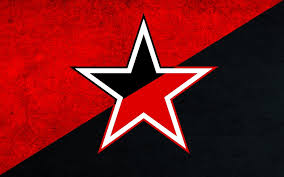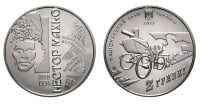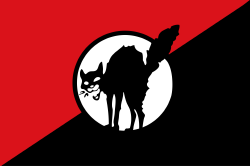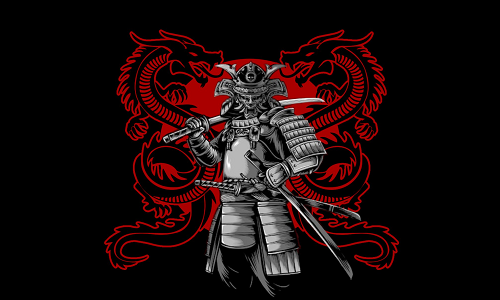| National Factbook |
| Flag: |

|
| Nation Name: |
Anarchist confederation |
| Leader Name: |
Willicitek |
| Currency: |

Makhnohroshi |
| National Animal: |

Black cat |
| History: |
Anarchia was founded on February 22, 2025, in Montpellier, France, following a period of intense social unrest and economic collapse in the region. The movement that led to its creation emerged from a coalition of local anarchist syndicates, mutual aid groups, and ecological municipalist assemblies, inspired by the traditions of Spain’s CNT-FAI and the communalist philosophy of Murray Bookchin.
A decisive moment occurred when the French government, struggling with deepening financial crises and widespread protests against austerity, withdrew key administrative and economic support from the Occitanie region. This power vacuum led to a spontaneous but well-organized response: local worker cooperatives, community councils, and revolutionary unions took control of essential services and declared Anarchia an independent confederation of self-governing communes.
The movement’s de facto leader, Willicitek, was elected as the first Delegate to the Confederation, serving as a coordinator rather than a ruler, as per anarchist principles. The confederation immediately abolished centralized state control, replacing it with direct democracy, self-managed production, and a decentralized federation of communes. |
| Geography |
| Continent: |
Europe |
| Land Area: |
24,301.03 sq. km |
| Terrain: |
Anarchia has various landscapes, making it a region of rich ecological diversity. Located in the Occitanie region of southern France, it features coastal plains, rolling hills, fertile farmland, and forested areas. These diverse terrains shape the confederation’s sustainability and self-sufficiency.
The southernmost part of Anarchia borders the Mediterranean Sea, offering access to fishing, salt production, and trade routes. The coastline includes sandy beaches, salt marshes, and lagoons, which serve as habitats for diverse marine life. Fishing cooperatives use sustainable aquaculture methods, while seaweed harvesting and desalination projects support the economy.
Further inland, Anarchia’s fertile plains are ideal for vineyards, olive groves, and cereal production. The Mediterranean climate, with hot summers and mild winters, allows for year-round farming. Crops like grapes, wheat, olives, figs, almonds, and lavender flourish, alongside agroecological farms promoting sustainability.
Water is sourced from small rivers, wells, and reservoirs, ensuring independence from external supplies. Free-range cattle, sheep, and goats contribute to dairy and wool production in self-managed pastoral farms.
To the north and west, rolling hills and dense forests form a natural barrier, covered in oak, pine, and chestnut trees. These woodlands provide timber, firewood, and medicinal plants, managed through sustainable forestry. Many communes in these areas emphasize eco-friendly living and off-grid energy solutions like wind and solar power.
A network of small rivers and streams runs through Anarchia, providing clean water, irrigation, and hydroelectric power. Rainwater collection and gray water recycling ensure efficient water use. Several natural springs supply fresh drinking water and support thermal bath cooperatives.
Limestone caves and rocky cliffs in the more rugged areas serve as storage spaces, refuges, and underground farms. Some caves are used for mushroom cultivation, preservation cellars, and communal meeting spaces. These natural formations provide defensible positions for local militias when needed.
Anarchia has a Mediterranean climate with long, dry summers and mild, wet winters. While this fosters agricultural abundance, the region faces risks like droughts, wildfires, and flash floods. To combat these, communes have implemented fire prevention programs, irrigation systems, and reforestation efforts.
Anarchia’s diverse terrain—from coastal fisheries to fertile farmlands, rolling hills to underground networks—is deeply linked to its self-sufficiency and ecological principles. The landscape supports its decentralized, sustainable, and communal way of life, proving that a stateless society can thrive in harmony with nature. |
| Highest Peak: |
Mt. Egalitat,
1,342 meters
|
| Lowest Valley: |
Val de l'Adelfitat,
28 meters
|
| Climate: |
Anarchia experiences a Mediterranean climate, defined by hot, dry summers and mild, wet winters. This climate supports the region’s agricultural productivity while also presenting environmental challenges that require careful management.
Summers in Anarchia are long and warm, with temperatures averaging 28-35°C (82-95°F). Heatwaves are common, making shade cultivation and water conservation essential for farming communities. The abundance of sunshine makes Anarchia ideal for solar energy production, which powers many communal settlements.
Winters are mild and humid, with temperatures rarely dropping below 5°C (41°F). Frost is uncommon, allowing for year-round crop cycles and reducing the need for energy-intensive heating systems. Rainfall is more frequent during winter, replenishing natural reservoirs, rivers, and aquifers.
Rainfall in Anarchia is seasonal, concentrated primarily in autumn and winter. Annual precipitation levels range from 500-900 mm (20-35 inches), ensuring a stable water supply for agriculture and daily use. However, the dry summers necessitate efficient irrigation systems, rainwater harvesting, and gray water recycling to prevent shortages.
Flash floods can occur in river valleys after heavy storms, particularly in early autumn. To mitigate damage, communes have implemented natural flood control measures, including terraced farming, retention basins, and reforestation projects.
Anarchia experiences several dominant wind patterns, the most notable being the Mistral, a strong, dry wind from the north. The Mistral can cool summer temperatures but also increases the risk of wildfires. In response, the confederation has developed firebreaks, community firefighting teams, and controlled burns to protect forests and farmlands.
Gentler sea breezes from the Mediterranean moderate temperatures along the coast, providing relief from extreme heat. These winds also support wind power generation, contributing to Anarchia’s renewable energy infrastructure.
As a predominantly self-sufficient region, Anarchia actively implements climate resilience strategies to counteract environmental risks. Drought-resistant crops, permaculture techniques, and cooperative water-sharing agreements ensure that agriculture remains sustainable despite seasonal dryness.
To combat desertification and soil erosion, afforestation projects and regenerative farming have been widely adopted. Communes work collectively to maintain a balanced ecosystem, ensuring long-term prosperity for the people and environment of Anarchia.
Anarchia’s Mediterranean climate, while favorable for agriculture and renewable energy, demands careful resource management. Through collective action, sustainable technology, and ecological stewardship, the confederation continues to thrive in harmony with its natural surroundings. |
| People & Society |
| Population: |
1,567,661 people |
| Demonym: |
Anarchian |
| Demonym Plural: |
Anarchians |
| Ethnic Groups: |
Occitàn - 52.0%
French - 24.0%
Catalàn - 10.0% |
| Languages: |
French - 85.0%
Occitàn - 55.0%
Catalàn - 20.0% |
| Religions: |
Atheism - 60.0%
Christanity - 25.0%
Islam - 10.0% |
| Health |
| Life Expectancy: |
77 years |
| Obesity: |
12.7% |
| Alcohol Users: |
48.2% |
| Tobacco Users: |
16.9% |
| Cannabis Users: |
22.5% |
| Hard Drug Users: |
6.3% |
| Economy |
| Description: |
Anarchia operates a self-managed, decentralized economy based on cooperatives, mutual aid, and sustainable resource management. Inspired by Spanish anarchist movements (CNT-FAI) and Murray Bookchin’s municipalism, its economic structure prioritizes communal ownership, local decision-making, and ecological balance.
Anarchia’s official currency is the Makhnohroshi, named after anarchist revolutionaries Nestor Makhno and Alexander Berkman (Roshchin). The economy has a Gross Domestic Product (GDP) of $595,323,869, with a per capita income of $2,437.01. While modest by global standards, the emphasis is on needs-based distribution rather than profit accumulation.
The economy is structured around self-sufficient communes, each specializing in different industries while engaging in barter, mutual credit, and cooperative trade.
Agriculture is the backbone of Anarchia’s economy. Communes practice permaculture, agroecology, and cooperative farming, producing essential goods such as:
Grains (wheat, barley, rye)
Fruits and vegetables (olives, grapes, figs, almonds, tomatoes, peppers)
Livestock and dairy (goats, sheep, cattle, and poultry)
Fishing and aquaculture (Mediterranean fish, shellfish, seaweed farming)
Self-sufficient food production ensures that exports are minimal, with surplus shared through inter-communal trade networks.
Anarchia invests heavily in sustainable energy and local manufacturing:
Solar and wind power provide most electricity needs.
Hydroelectric micro-dams power rural communities.
Worker-run factories produce textiles, furniture, tools, and eco-friendly construction materials.
Localized metal and wood workshops craft essential goods, reducing reliance on imports.
Rather than a centralized market, Anarchia operates through mutual credit systems, time banks, and barter networks. Essential imports (such as medicine and technology) are obtained through direct cooperative agreements with external partners.
The Port of Anarchia facilitates limited maritime trade, allowing for selective imports in exchange for artisanal and agricultural products.
Fair-trade networks connect Anarchia with like-minded international cooperatives.
Scientific research and education are seen as public goods. Communes pool resources to fund open-source technology, ecological research, and decentralized learning institutions. Key areas of focus include:
Sustainable farming innovations
Renewable energy advancements
Biodegradable materials and eco-construction
Eco-tourism and communal cultural exchanges contribute to the economy:
Visitors engage in educational stays, learning about anarchist municipalism and sustainable living.
Work-exchange programs allow for participation in farming and cooperative projects.
Historical sites and natural reserves attract environmentally conscious travelers.
Economic Challenges and Adaptation |
| Average Yearly Income: |
$54.86 |
| Gross Domestic Product (GDP): |
$2,333,042,597.00 |
| GDP per Capita: |
$1,488.23 |
| Gross National Income (GNI): |
$1,431,437,290.00 |
| Industries: |
Industry of Anarchia
Anarchia’s industry is based on worker self-management, sustainability, and decentralized production. Rather than centralized corporations, industries operate as federated cooperatives, ensuring democratic decision-making and local resource-sharing.
Key Industrial Sectors
Anarchia prioritizes sustainable, localized industries, reducing reliance on imports. The main sectors include renewable energy, eco-friendly manufacturing, artisanal production, and resource extraction.
1. Renewable Energy
To remain energy-independent, Anarchia focuses on clean energy sources:
Solar farms and wind cooperatives provide most electricity.
Micro-hydroelectric plants support rural areas.
Biofuel production from agricultural waste reduces fossil fuel use.
Communes contribute to a shared energy grid, ensuring fair distribution.
2. Manufacturing and Craft Industries
Anarchia emphasizes eco-friendly, small-scale production:
Textile cooperatives produce organic cotton and hemp clothing.
Sustainable construction materials include recycled wood and bio-insulation.
Furniture and tool workshops use responsibly harvested resources.
Printing presses support education and media freedom.
3. Metalworking and Machinery
Heavy industry is small-scale to reduce environmental impact:
Metalworking cooperatives recycle and refine materials for tools and infrastructure.
Woodworking guilds create furniture and construction materials.
Machinery workshops produce farming tools and renewable energy components.
4. Resource Extraction and Recycling
Anarchia prioritizes sustainable resource management:
Stone quarries and salt production operate at minimal ecological cost.
Recycling centers repurpose materials, reducing waste.
Forestry projects ensure sustainable wood harvesting.
5. Science and Innovation
Despite its focus on traditional crafts, Anarchia supports technological progress:
Renewable energy innovation, improving solar and wind efficiency.
Biodegradable material research, reducing plastic dependence.
Decentralized digital networks, enhancing secure communication.
Medical cooperatives, researching herbal and holistic treatments.
6. Transport and Infrastructure
Anarchia maintains an eco-friendly transport system:
Public trams and buses reduce reliance on cars.
Bicycle production cooperatives promote sustainable transit.
Electric cargo vehicles and wind-powered ships support trade.
Challenges and Future Development
Challenges include limited trade, resource constraints, and geopolitical pressures. Solutions focus on self-reliance, recycling, and open-source innovation.
Anarchia’s industry is worker-run, sustainable, and innovative. By rejecting mass production and prioritizing localized, cooperative industries, the confederation builds a resilient, self-sufficient economy.
|
| Military |
| History: |
Military of Anarchia
Anarchia’s defense structure is based on decentralized militias, self-defense cooperatives, and direct community participation. Rooted in anarchist principles, it rejects a traditional standing army in favor of a federated defense network that ensures security while preventing authoritarian control.
1. Structure and Organization
Instead of a centralized military, Anarchia relies on:
The People’s Defense Committees (PDCs): Autonomous regional militias responsible for local defense.
The Rapid Response Network (RRN): A voluntary, highly mobile force that coordinates between communes during emergencies.
The Revolutionary Defense Federation (RDF): A confederation-wide body facilitating strategy, training, and logistics.
2. Training and Recruitment
Anarchia’s defense forces operate on a voluntary, rotational basis, ensuring every able-bodied citizen receives training:
Community Defense Training: Basic self-defense, first aid, and crisis response.
Advanced Militia Programs: Tactical coordination, guerrilla warfare, and cyber defense.
Nonviolent Resistance Units: Specialized in civil disobedience and psychological operations against external threats.
3. Weapons and Equipment
Anarchia maintains self-sufficient arms production, prioritizing defensive and guerilla tactics:
Locally produced firearms from cooperative workshops.
Light armored vehicles, built for rapid movement and defense.
Cybersecurity divisions, protecting communication networks.
Drones and surveillance balloons, used for reconnaissance.
4. Naval and Coastal Defense
Due to its coastal location, Anarchia maintains a small but effective naval defense system:
Maritime Defense Units (MDUs): Patrol coastal waters with small, fast boats.
Anti-Piracy and Smuggling Teams: Prevent illicit activity while ensuring secure trade.
Coastal Watch Networks: Volunteer-led monitoring of maritime threats.
5. External Alliances and Diplomacy
Anarchia prioritizes defensive alliances and mutual aid agreements over aggression:
Solidarity pacts with anarchist and municipalist movements worldwide.
Non-aggression treaties with neighboring states.
International volunteer brigades, allowing ideological allies to train and assist.
6. Challenges and Strategies
Challenges include external hostility, supply limitations, and hybrid warfare threats. To counter these, Anarchia emphasizes:
Decentralized command structures, making occupation difficult.
Strong local resilience, ensuring communities can function under siege.
International solidarity, leveraging diplomatic pressure and grassroots movements.
Anarchia’s military model ensures defense without hierarchy, allowing free communes to remain secure while upholding anarchist ideals. Its militia-based system, voluntary training, and strategic alliances create a resilient and adaptive defense network without the risks of militarization.
|
| Soldiers: |
116,207 |
| Tanks: |
7,327 |
| Aircraft: |
372 |
| Ships: |
0 |
| Missiles: |
0 |
| Nuclear Weapons: |
0 |
| Last Updated: 02/27/2025 10:11 pm |

















